The best pork tenderloin recipe you will ever make! Oven-roasted pork tenderloin is infused with sage, garlic, and rosemary. Seared for a savory crust, then roasted in the oven for a tender, juicy bite that melts in your mouth. Drizzle with a decadent, buttery pan sauce to elevate your weeknight meal! This quick and easy dinner takes less than 30 minutes to make, yet it’s still perfect for a date night at home or a beautiful dinner with family.
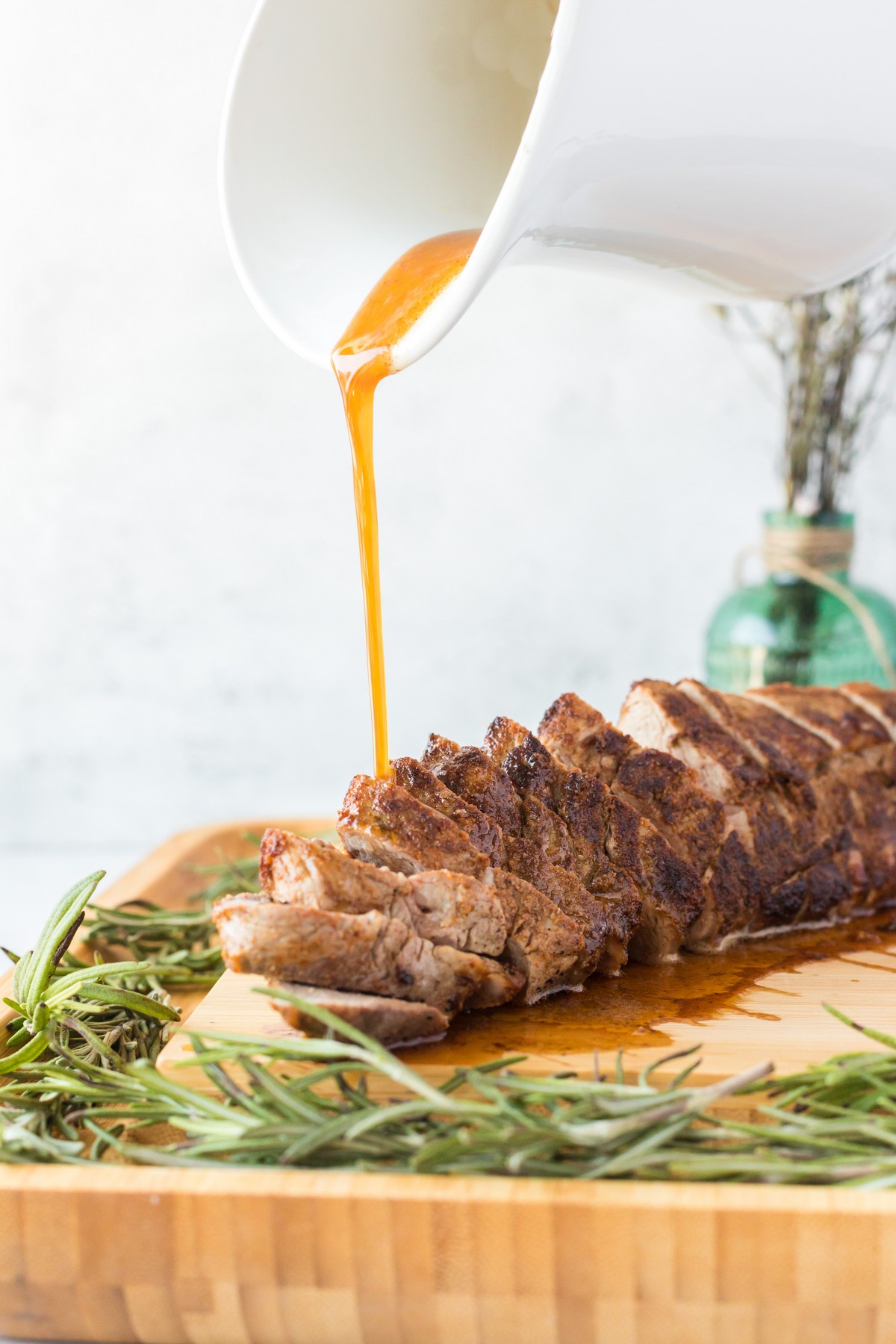
This roasted pork tenderloin has a crispy, caramelized crust with a tender, juicy interior that you won’t be able to get enough of! Prepared with a simple dry rub and served with a buttery sauce, everyone will be asking you for the recipe!
I’m a firm believer that you don’t need to be a professionally trained chef to prepare perfectly cooked meat. I’ll show you how easy it is to turn a restaurant-quality meal into your new go-to family favorite for busy weeknights.
What is Pork Tenderloin?
Pork tenderloin is a boneless, “extra lean” cut of meat with an excellent nutritional profile. It’s extremely tender (hence the name), which makes cooking a breeze. Plus, it can easily be seasoned in a wide variety of ways.
One of my favorite ways to prepare pork tenderloin is to sear and roast it. Searing pork tenderloin is the best way to get that crusty outer layer that locks in juices and tons of flavor!
I went with a simple yet flavor-packed rub, blending sage, garlic, onion, and paprika. With the addition of fresh rosemary, the only thing that may rival the taste is the cozy smell that fills your kitchen!
Pork Tenderloin vs Pork Loin
You may have heard pork tenderloin called by other names such as pork fillet or pork tender. But, none of these three are the same as pork loin. In fact, tenderloin and loin are two completely different cuts of meat, each requiring its own cooking method.
- Tenderloin: This cut comes from the muscle along the backbone. It’s long, narrow, and boneless. Compared to loin, it has a more mild, lean flavor.
- Pork loin: Sometimes called rib roast, pork loin is a larger, fattier cut that comes either boneless or bone-in. It carries a richer flavor with a tender texture.
In this recipe, we’re roasting pork tenderloin! If you are unsure which type you’re buying, make sure to double-check with the butcher.
Pork Tenderloin Internal Temperature
Pork is a little finicky to prepare. Undercooking can lead to illness while overcooking will lead to tough, flavorless meat.
Many folks insist that you must cook all pork until it reaches 145 degrees internally. However, this preparation method removes the pork from the oven at a much lower temperature. As the meat rests, the internal temperature continues to rise. This is called “carry-over cooking”.
Carry-over cooking occurs when the ingredients are removed from the heat source (oven, grill, skillet, etc.), but the cooking continues as the temperature is released from the meat.
Depending on the recipe, the internal temperature of the food can increase by 5-25 degrees in a matter of minutes during carry-over cooking. This method is 100% safe and the risk of foodborne illness is no more than any other preparation method.
Depending on the weight and thickness of your pork tenderloin and how you like your meat prepared, you may choose to roast it a little longer or allow it to rest longer than noted. Please see the notes in the recipe card below!
With all of that said, this is where a meat thermometer comes in handy! Seriously, it will make life so much easier.
Ingredients For Roasted Pork Tenderloin
See the full list of ingredients in the recipe card below.
- Pork: It’s important to use an already-tender cut of pork since it won’t be roasted for very long. This is why cuts that come from higher up on the animal, such as pork tenderloin, are the ideal choice for quick-roasting recipes like this.
- Dry rub: I like to make a simple homemade rub seasoning. Garlic powder, onion powder, and sage add savory elements while paprika provides a touch of smokiness.
- Fresh garlic: Pop a few cloves of fresh garlic into the skillet before roasting the pork tenderloin for extra hearty, savory notes.
- Butter & olive oil: I sear my pork tenderloin in both butter and olive oil for richer flavors. For a lighter version, stick to only olive oil. Butter also makes up part of the serving sauce, creating an incredibly decadent meal.
- Rosemary: Paired with sage, the fresh rosemary adds yet another layer of herbaceous, earthy flavors that make this dish feel cozy and comforting.
How to Cook Roasted Pork Tenderloin
Step 1: Mix the Rub
Before you start anything else, make sure your oven is preheating to 450°F degrees. Since the pork tenderloin only roasts for about 10 minutes, the temperature is high and hot!
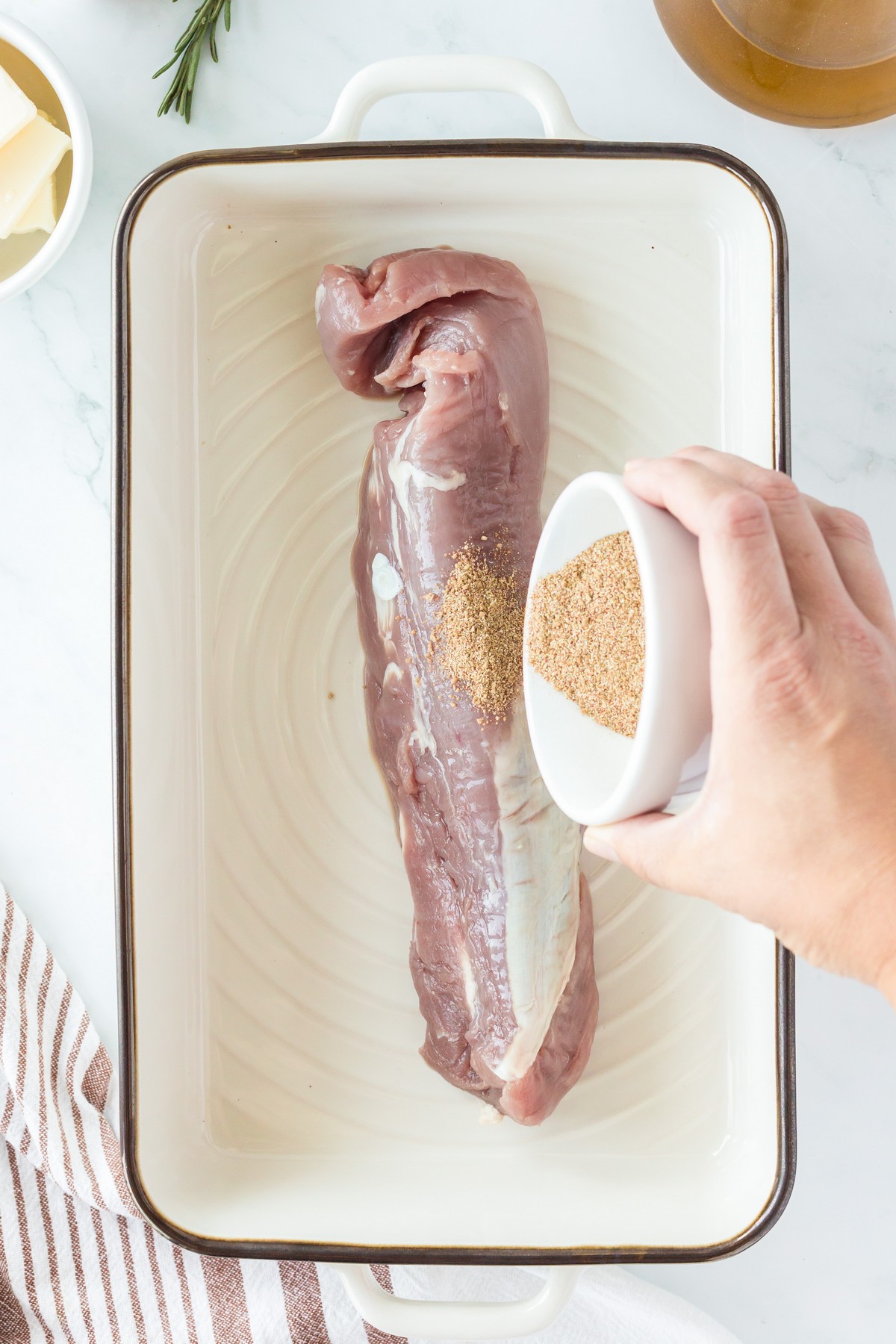
Once the oven is on, mix together the garlic powder, onion powder, dried sage, salt, and paprika in a small bowl.
Step 2: Season the Pork
Sprinkle the rub on all sides of the pork tenderloin, turning and pressing the mixture into the meat so it adheres well. I recommend applying the rub in a 9×13 casserole dish for easier clean-up.
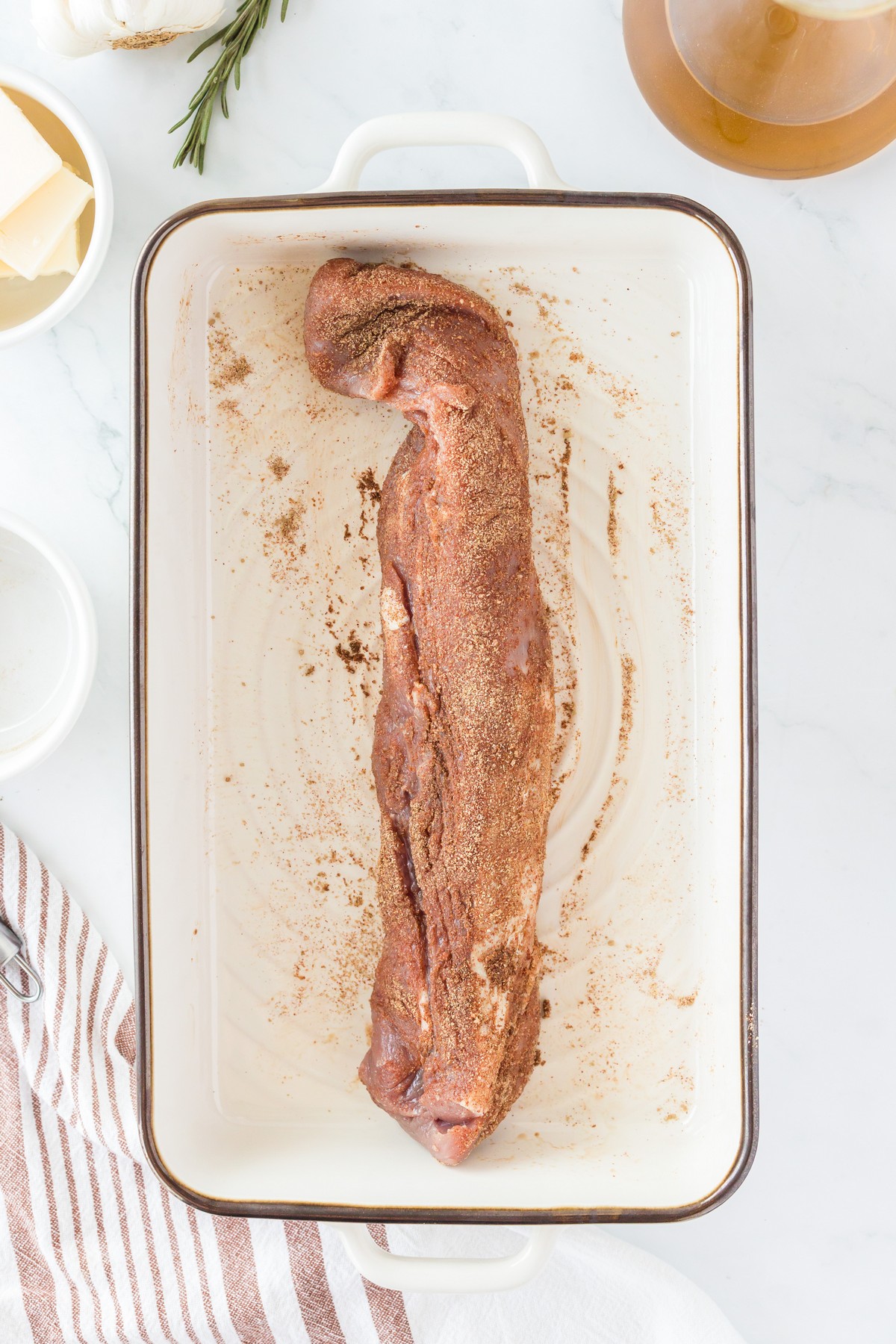
Make sure you really work the rub into the meat so it is evenly coated and seasoned well.
Step 3: Sear the Tenderloin
In a large cast-iron skillet over medium-high heat, melt one tablespoon of butter with the olive oil. If you don’t have a cast-iron skillet, make sure whatever pan you are using is oven-safe. Otherwise, you will need to sear and roast it in separate dishes.
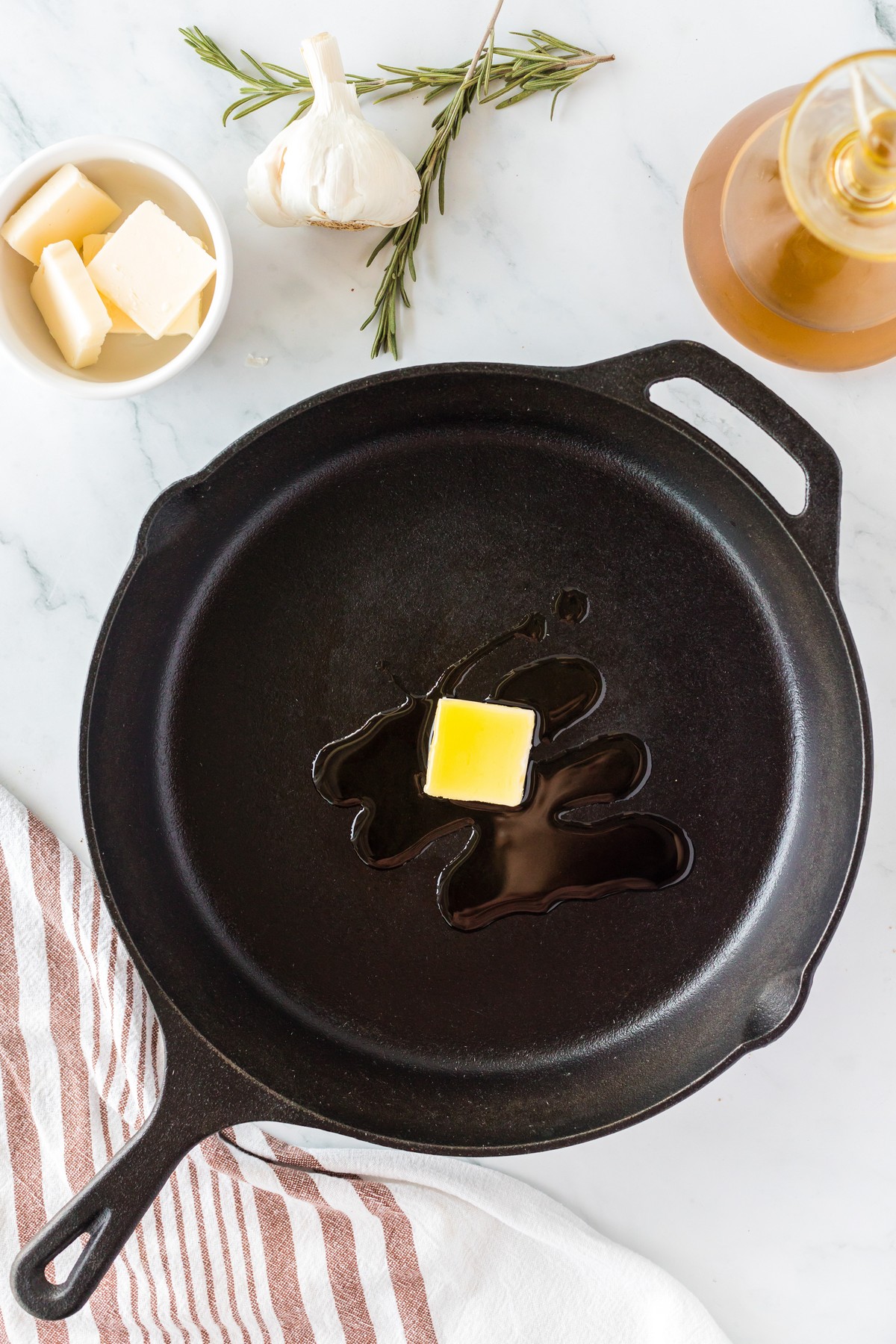
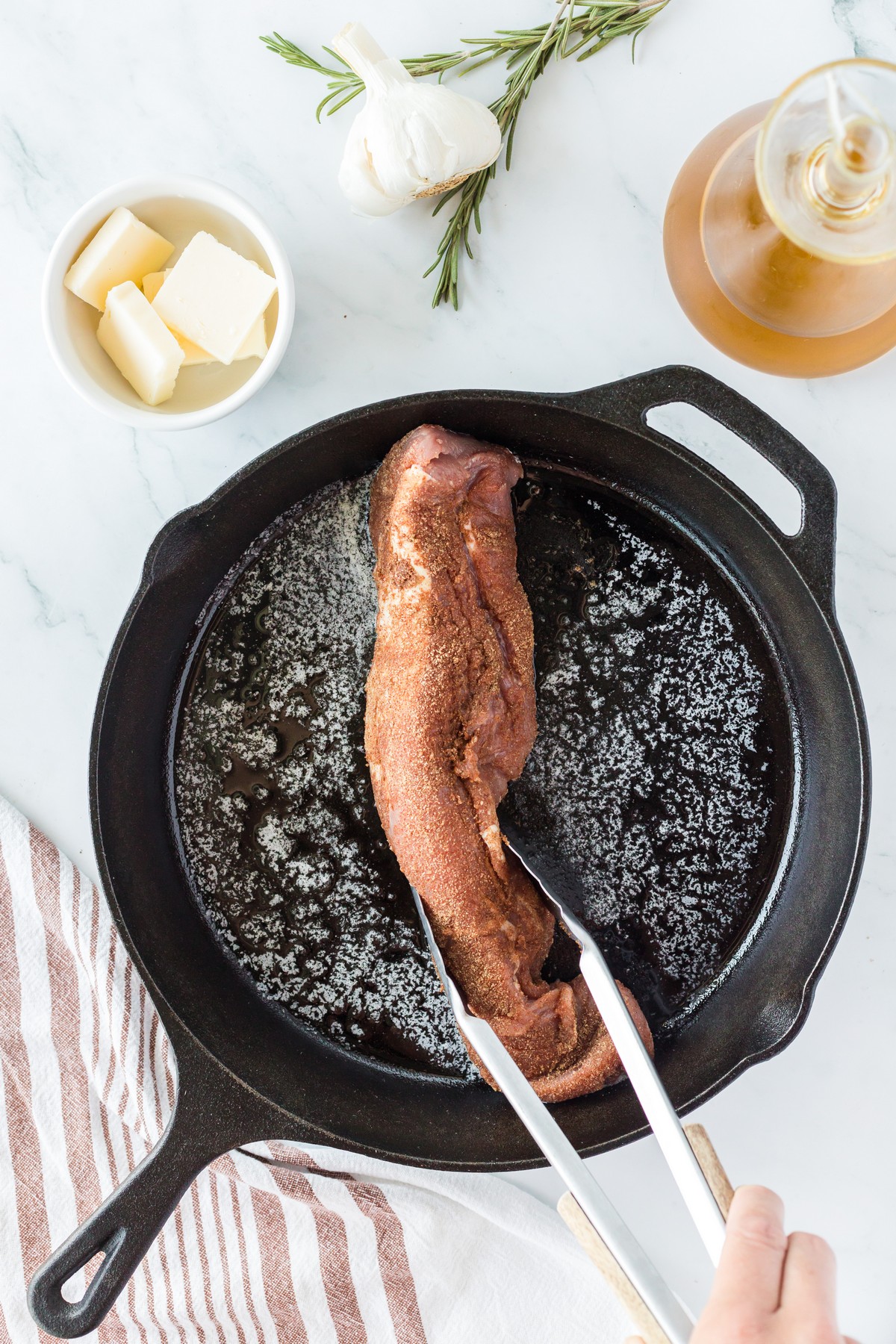
You only need to sear the pork tenderloin on each side for a few minutes. It should appear golden brown in color.
Step 4: Roast the Pork Tenderloin
Once the meat is seared, it is ready to be roasted! Before you pop it in the oven, add the fresh garlic cloves, more butter, and sprigs of rosemary to the skillet.
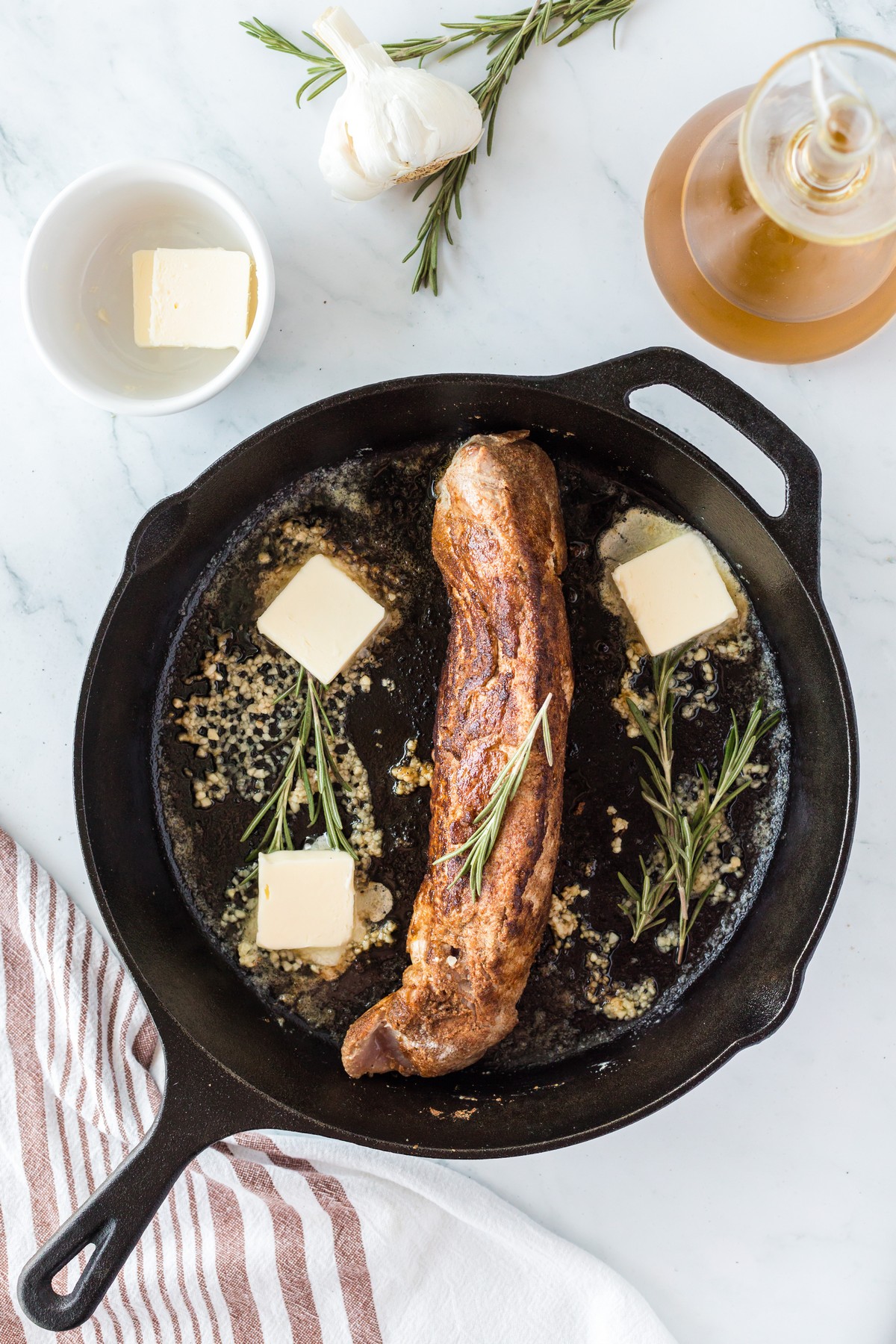
If your pork tenderloin is similar in size to mine (1 ¼ pound), it only needs to be roasted for 10 minutes uncovered.
If you have a larger cut, you may need to roast it for a few minutes longer, but check the internal temperature with a meat thermometer so it reads to your desired doneness. Remember, we will have a fair amount of carry-over cooking as we are roasting at such a high temperature.
Once the pork tenderloin is done, let it rest at room temperature for 10 minutes before slicing. The resting period gives the meat juices time to redistribute, ensuring you will have tender and juicy pork tenderloin all throughout.
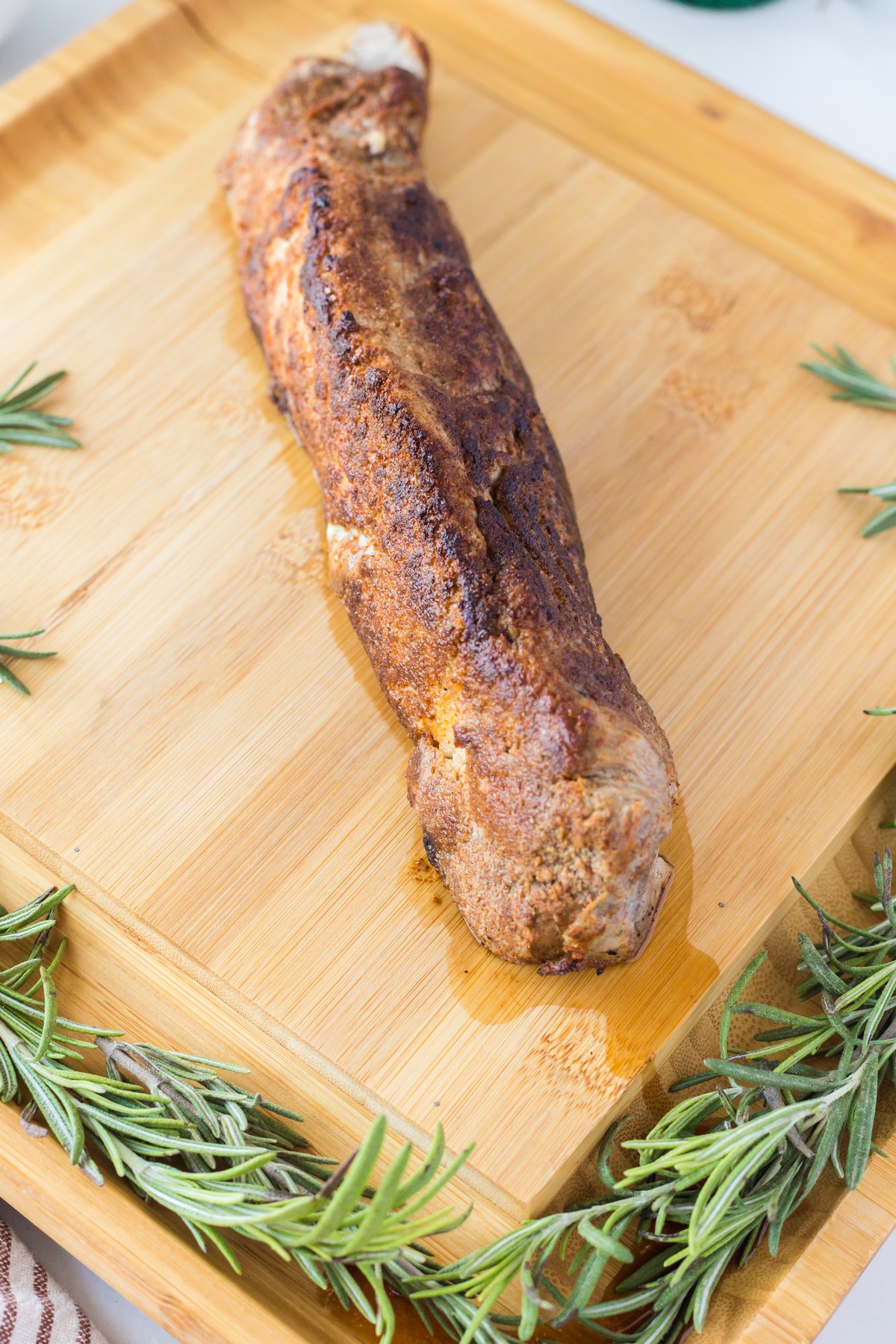
The internal temperature will continue to rise during resting. The longer you allow the meat to rest, the higher the temperature will climb. I prefer slicing at around 130°F.
Step 5: Make the Sauce
Transfer the pork out of the skillet to a welled cutting board or plate, then place the skillet back onto your stove. Without cleaning the skillet out (that’s where the flavor comes from), add the rest of the butter.
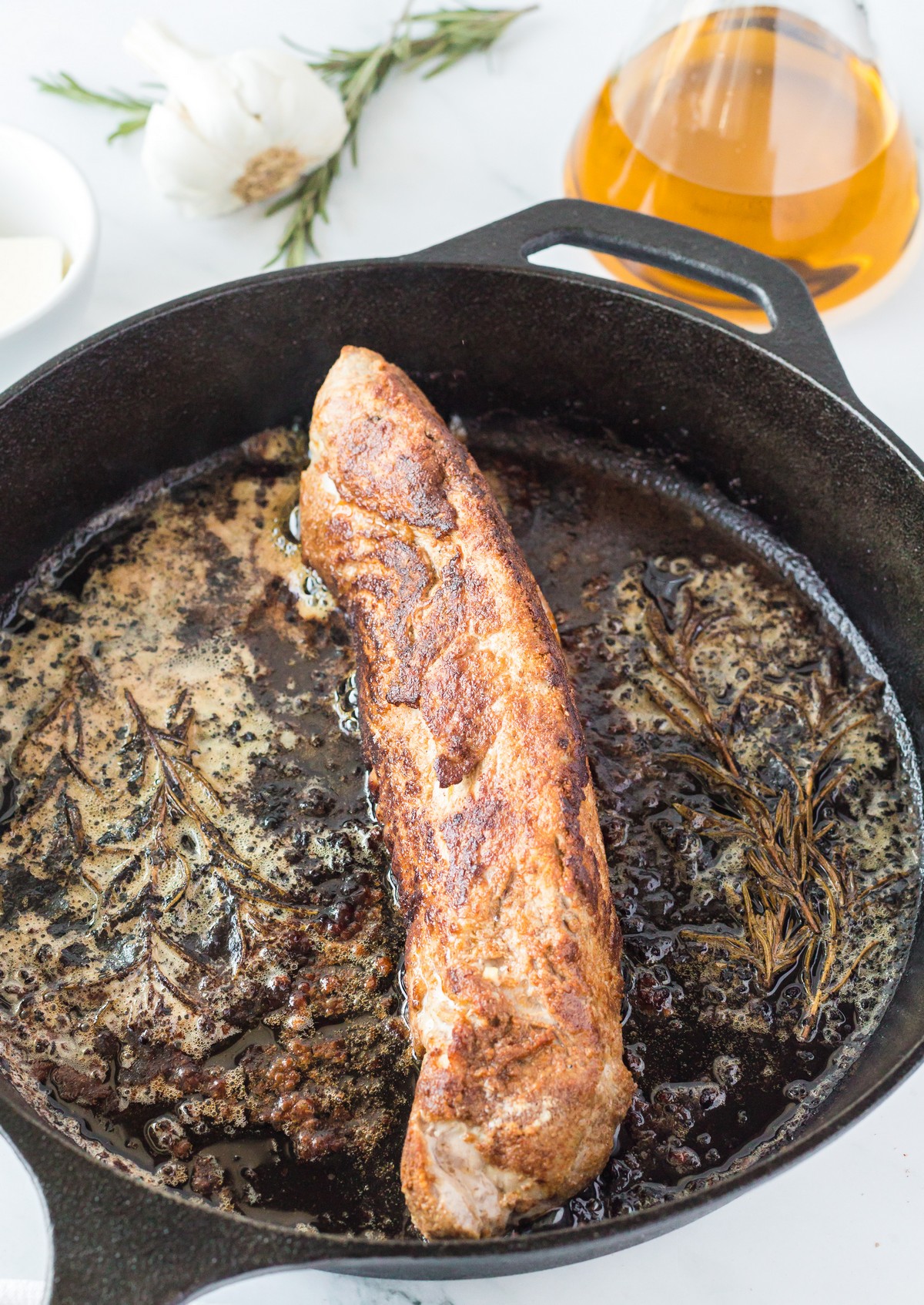
Gently scrape the bottom of the pan with a wooden spoon to lift all of the browned bits or “fond” and incorporate them into the sauce. The rosemary leaves will usually come right off. Be sure to remove the stems before serving.
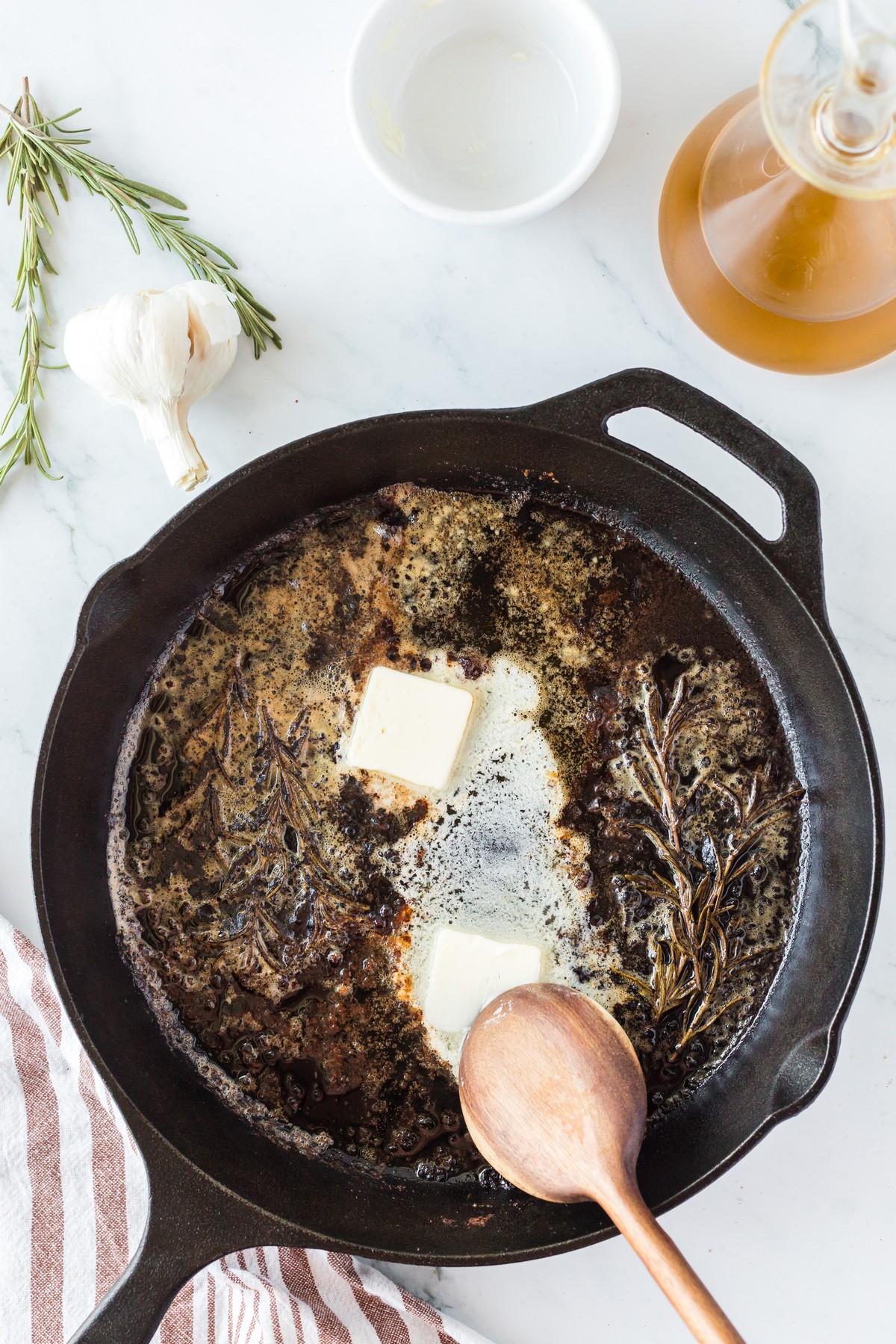
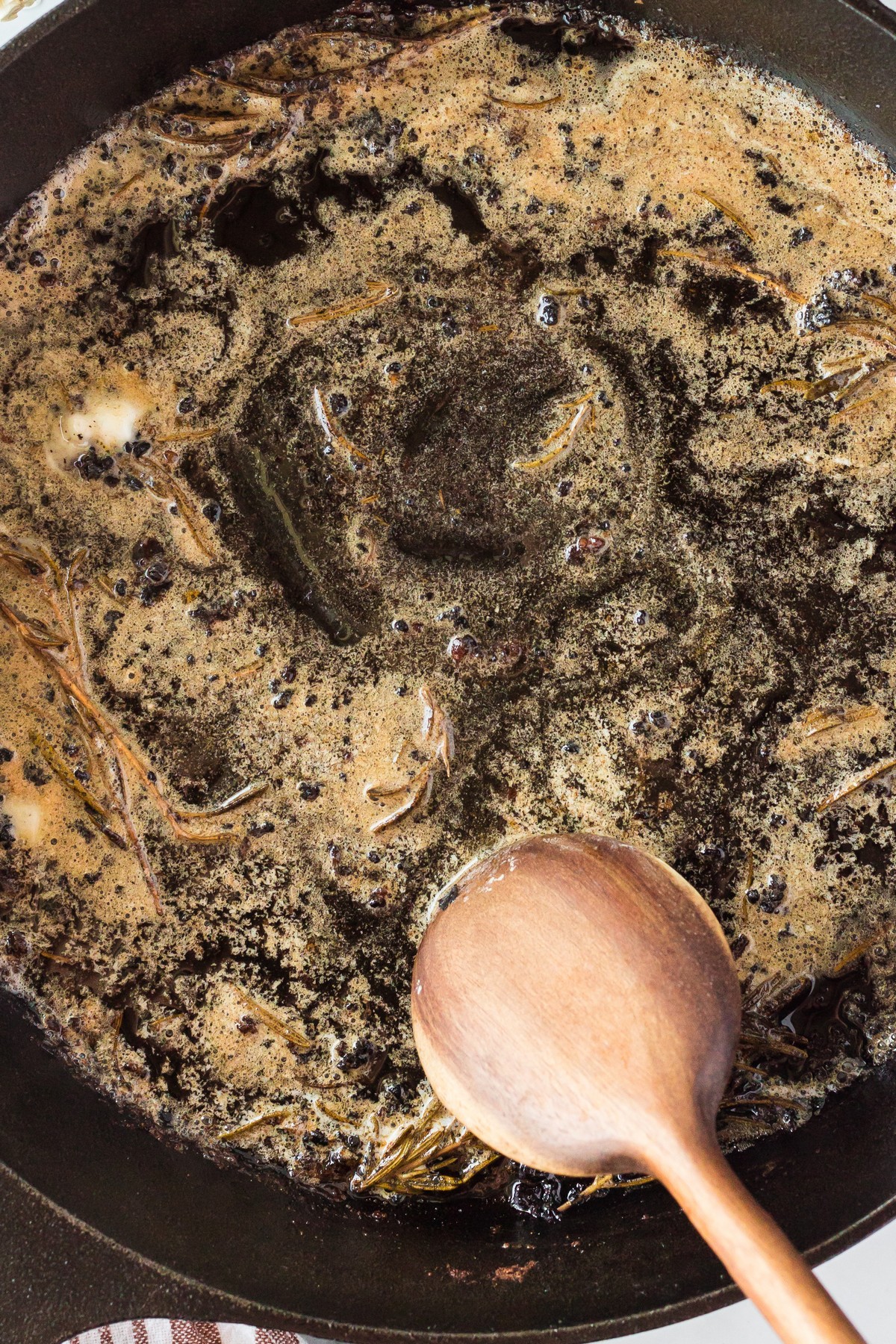
Depending on your stove and pan, you may need to turn the heat to low to get the butter to melt faster. This is an absolutely delicious sauce that makes the meal!
Step 6: Slice and Serve
After the pork tenderloin has rested, slice the meat into ½-inch thick slices and serve it with the sauce drizzled over top.

Serving Suggestions
For a well-rounded meal, this roasted pork tenderloin pairs incredibly well with savory side dishes like the following:
- Savory mashed sweet potatoes
- Easy twice-baked potatoes
- Air fryer french fries
- Crispy smashed red potatoes
Tips For The Best Recipe
- Invest in a thermometer. If I could give only one piece of advice, it would be to use a meat thermometer. Take the guesswork out of cooking your pork, and use a thermometer for the most consistent, safe, and accurate results.
- Let the meat rest. As I mentioned, giving the pork tenderloin enough time to rest will allow the juices to redistribute and not spill out when you go to slice it.
- Do not overcook. Pork is an especially important type of meat to not overcook. It will turn dry and tough very quickly. Monitor the internal temperature, and don’t let it cook too much past 145 degrees F for the most buttery texture.
- Sear the pork. To lock in the juices and add a beautiful crust, don’t skip searing your pork tenderloin before roasting it! It only takes an additional 5-8 minutes.
Storage & Leftovers
If you have leftover pork tenderloin, here are some storage tips and tasty ways to use up leftovers:
Fridge: Store pork tenderloin in the refrigerator for 3 to 4 days.
Freezer: Once cooled, I recommend wrapping your tenderloin in plastic wrap and placing it into a freezer-safe bag.
Reheating: If frozen, transfer the meat to the fridge to thaw overnight. Then, heat a little oil in a pan over low-medium, add the pork tenderloin, and cover until warm. You may need to flip it a few times for it to properly heat through, depending if it’s whole or sliced.
Leftovers: You can use leftover pork in chillis, tacos, fried rice, sliced for sandwiches, or paired with a fresh side dish.
Additional Recipes
For more protein-packed recipes, be sure to check out some of these fan favorites:
Frequently Asked Questions
Is it okay to eat pork tenderloin if it’s a little pink?
Yes. As long as the pork has been properly prepared to a safe internal temperature, a little pink in the middle is safe to eat.
Which herb is best to season pork with?
Although many herbs and spices pair well with pork, the combination of rosemary, sage, and paprika is one of my favorites.
How long does it take to cook pork tenderloin?
That answer largely depends on the size of your pork tenderloin and oven temperature. The best bet is to rely on the internal temperature of the meat rather than a rigid cook time.
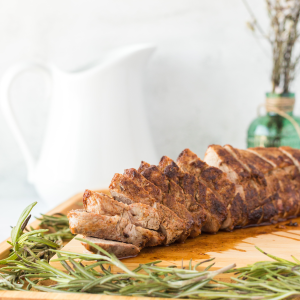
Oven Roasted Pork Tenderloin Recipe
Ingredients
- 1 ¼ pound pound pork tenderloin, at room temperature (These usually come in a pack of two. Use only one tenderloin)
- 1 teaspoon garlic powder
- 1 teaspoon salt
- 1 teaspoon onion powder
- 1 teaspoon dried sage
- 1 teaspoon paprika
- 6 tablespoons butter divided
- 1 tablespoon olive oil
- 4 cloves garlic minced
- 2 sprigs fresh rosemary
Instructions
- About 30 minutes before cooking, allow the meat to rest at room temperature for 30 minutes. This will prevent dry, tough meat.
- Preheat the oven to 450°F degrees.
- In a small bowl, mix together the garlic powder, onion powder, sage, salt, and paprika. Whisk to combine.
- Sprinkle the rub on all sides of the pork tenderloin, turning and pressing the mixture into the meat so it adheres well. (Do this in a 9×13 casserole dish for easier clean-up!)
- In a large cast iron skillet, melt one tablespoon of butter with the olive oil over medium-high heat.
- Once hot, add the tenderloin to the skillet and sear on each side (about 3 minutes each side), until golden brown. This should take about 5-8 minutes total.
- After searing, turn the stove off. Add the garlic cloves, 3 tablespoons of butter, and rosemary sprigs to the skillet. Place the skillet in the oven (uncovered) and roast for 10 minutes.
- After 10 minutes, remove from the oven and transfer the pork tenderloin to a cutting board with a well or a serving platter. Allow the meat to rest at room temperature for 10 minutes, or until the internal temperature reaches your desired doneness when read with a meat thermometer.
- While the pork tenderloin is resting, make the pan sauce (optional).
To Make the Pan Sauce:
- Without cleaning the cast iron skillet, add 2 tablespoons of butter to the skillet with the rosemary sprigs still remaining in the pan. (the pork tenderloin should be resting on a separate dish).
- Gently melt the butter in the hot pan and scrape up the browned bits from the bottom of the skillet with a wooden spoon. Remove the rosemary stems when the sauce is complete.
- After the pork tenderloin has rested for 10 minutes (or reaches desired doneness), slice the meat into ½-inch thick slices and serve with the sauce drizzled over the top.

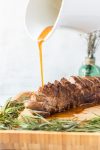

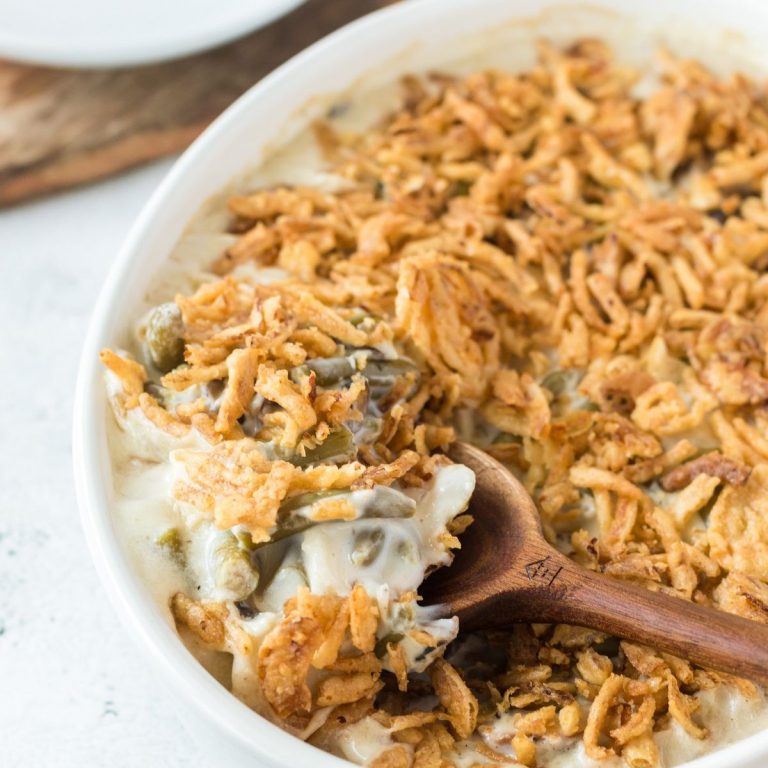
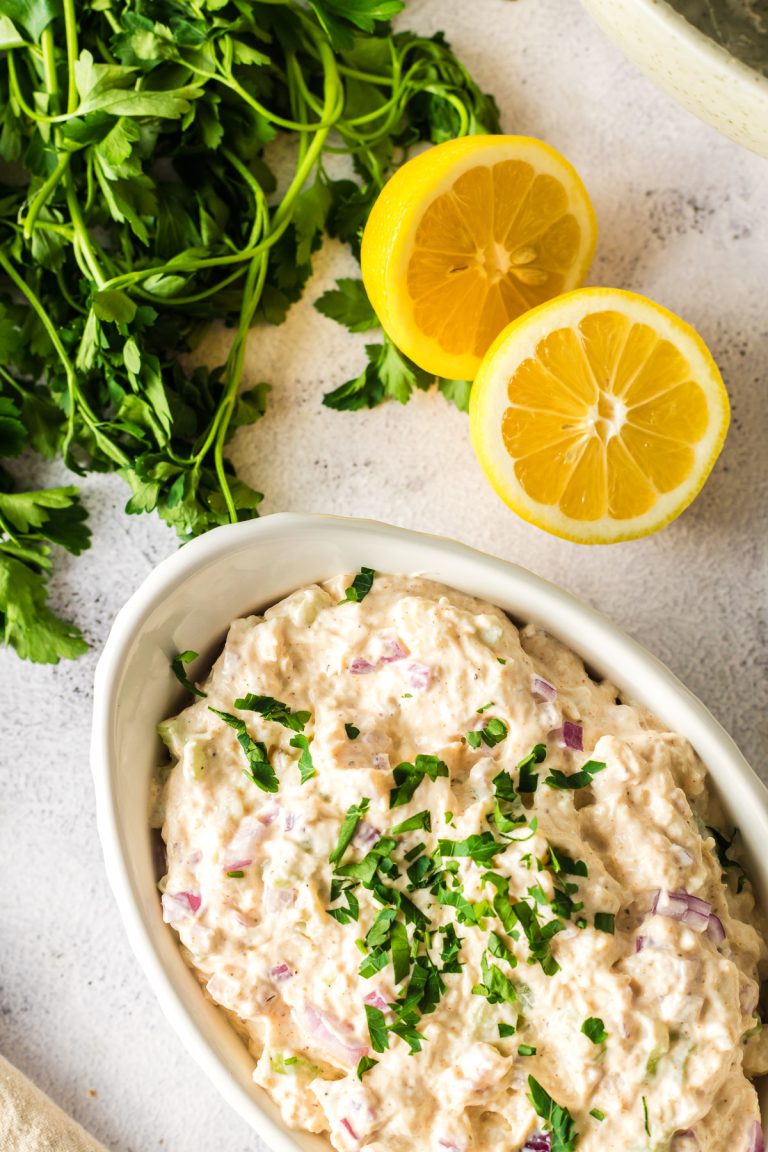
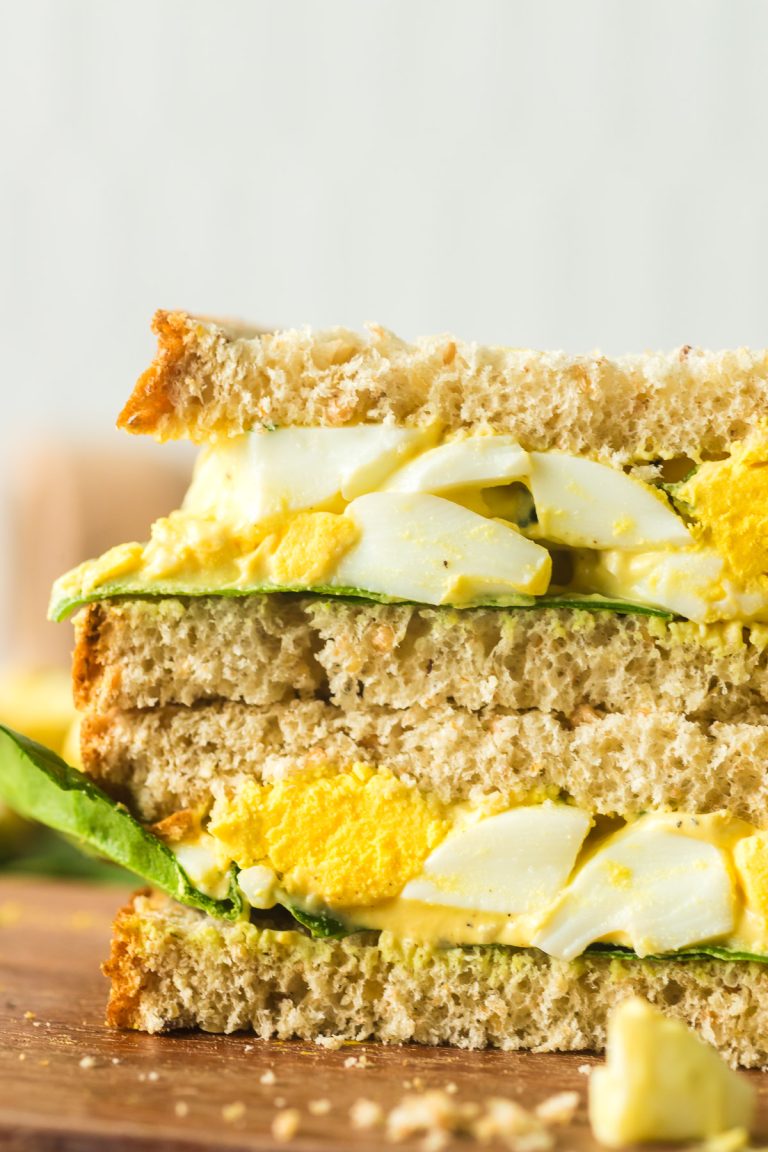
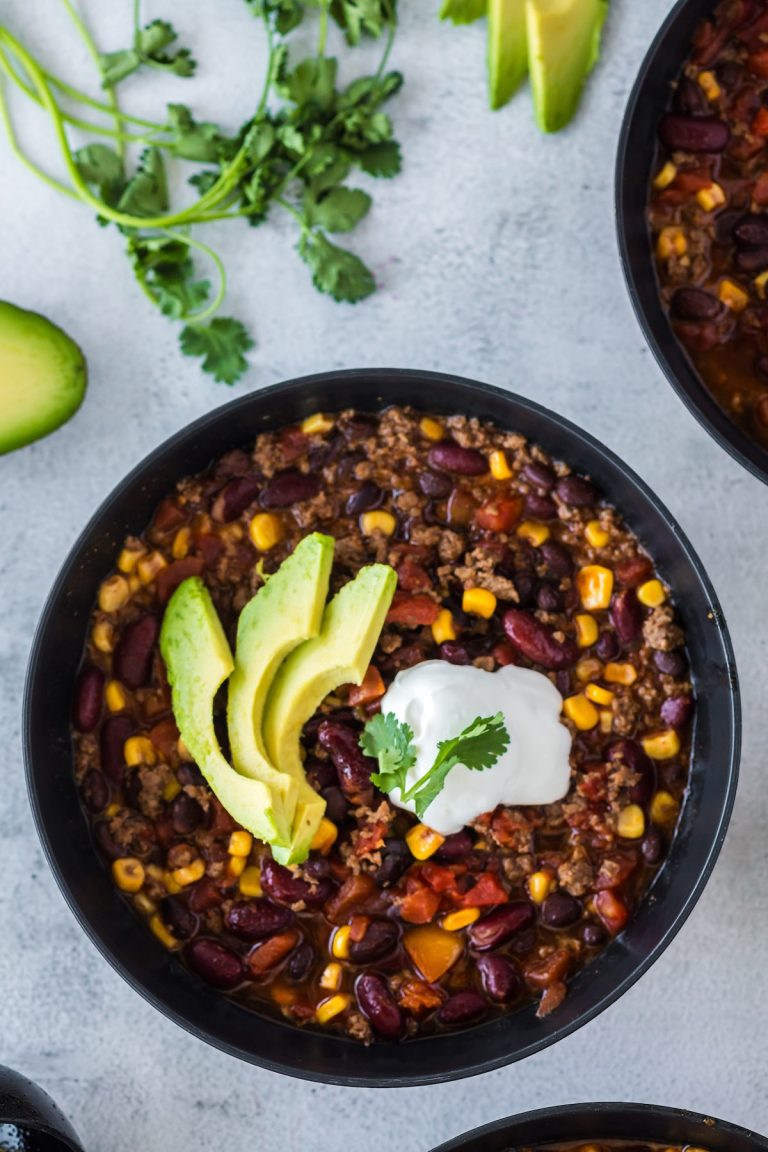
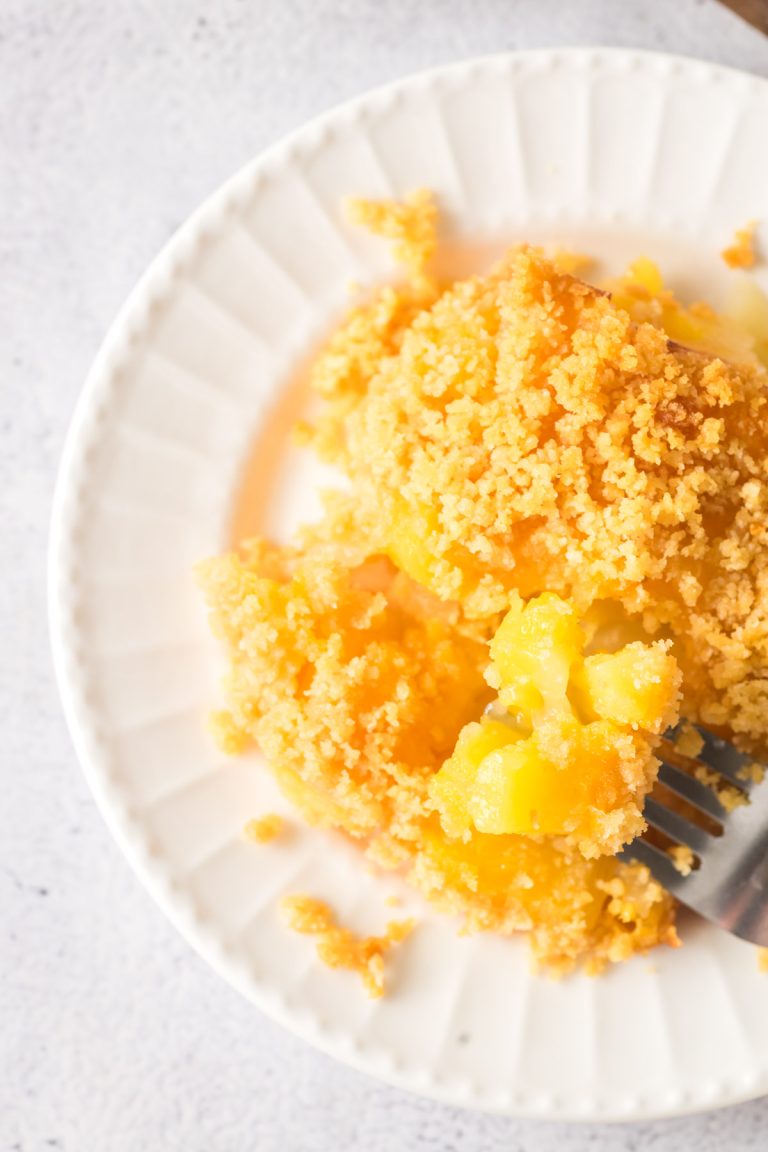
I made on this tonight for our little family New Year’s Eve celebration and it is wonderful. My husband cannot stop raving about it. It’s really delicious.